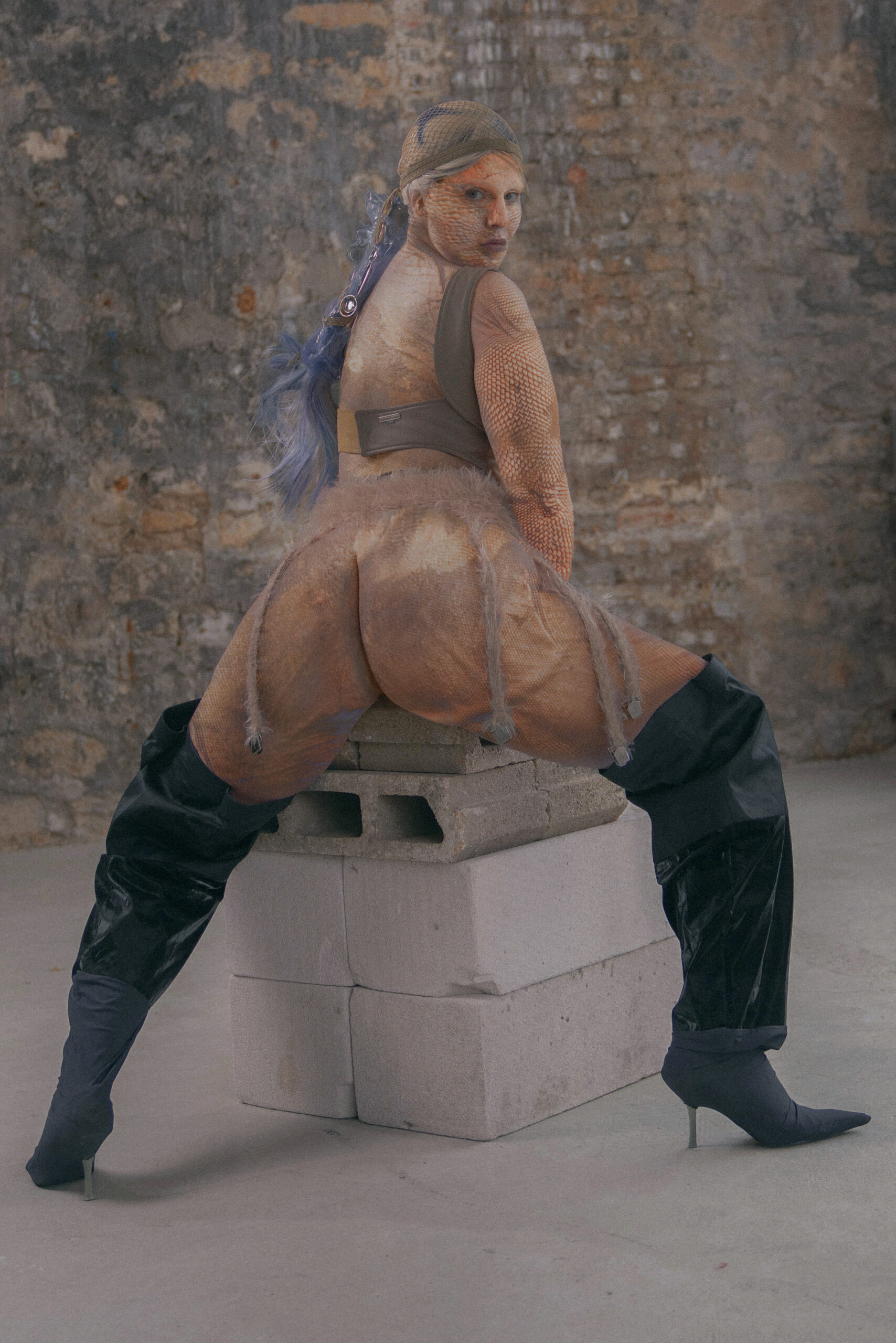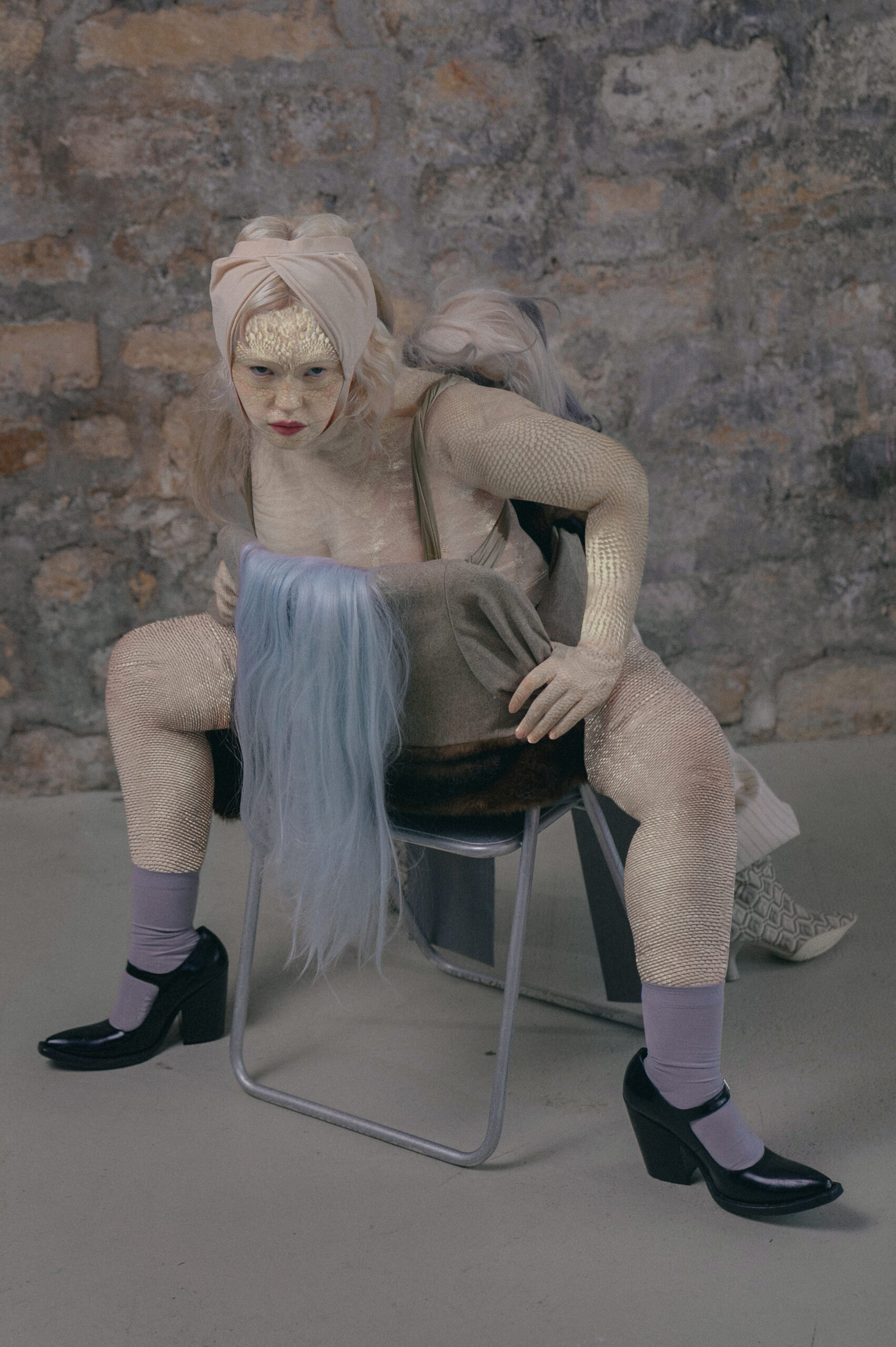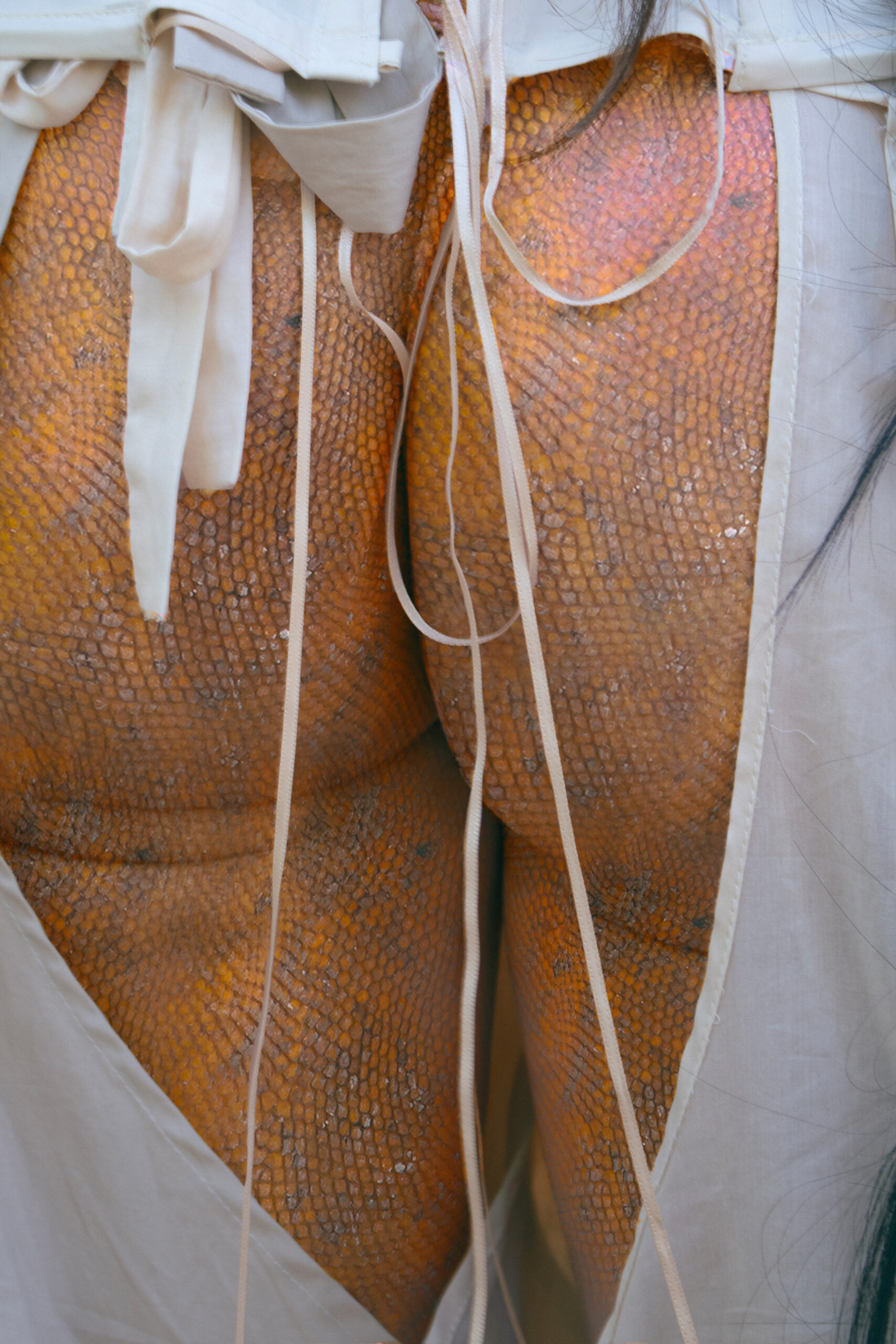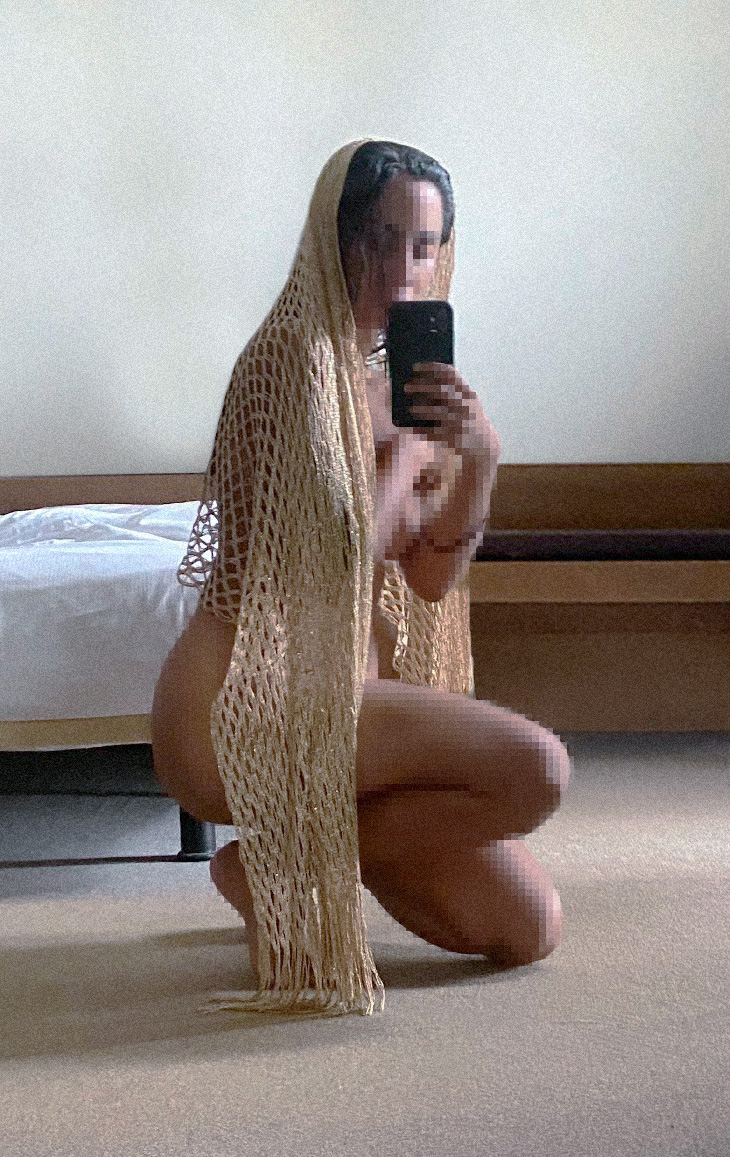“Everything that I believe is part of my delusional reality”

To simply describe Lolita Eno as an artist feels reductive. Her multi-media creations intersect the realms of art, fashion, design, philosophy and biology, creating an almost religious experience which examines the relationship between mother nature and the digital experience. Combining the beauty of the human form in one dimension, her work further conceptualises this beauty within another, tearing down the barriers of expectation or predictability. In a period where the transition between the ‘virtual’ and ‘reality’ is so blurred, Lolita Eno shares her heartfelt take on this new world and shares her wisdom on the beauty that can be found by remaining vulnerably receptive to life’s changes.
Your art is intimate, forward-thinking and inspired by a fusion between humans and nature. How would you personally describe your work?
It is a difficult question as I believe that I am in a state of constant change, and always heading in directions that I do not often control. I would therefore describe my work as more of an impulse coming from my gut; a black swan which I am able to sense in a very emotional way. Within this, as time goes by, I integrate what is in my head into my work, connecting the dots between the ideas that I think, feel and perceive. Through this method, I see my work as endowed with “empathy” and a very “earthly” feeling, which is then decontextualised and purely made up of biological sensations inherited by the living being. However, within this, my concept has adapted over time. I would say that today my work uses more conceptual contexts, as I always use the skin as a channel of “personalisation” and emotion. But ultimately, I love taking pictures of people and giving them a digitally created avatar in a world that comes purely from my imagination.
I love this concept of avatars, particularly in combination with the masterful lens through which your work is seen through…
Because the process of my work has a base in classic photography and performance, the whole experience of my work creates a collision between a “classic” photographic session and the digital part of the experience. This collision is an intimate experience with my own self through the creation of skins and layering. I believe that we are all in a constant state of change, therefore the world also changes (even if you don’t want it to). The changes in the skin which can be seen in my work represent that constant biological change and the adaptation to the environments that I create visually and digitally. Today I can say that my work is adaptive to the medium, to the context, to the photo and to the performance, being faithful to the concept of each project.
How do you perceive the role of digitalisation within your artistry?
Originally I felt that my work had a more digital and organic format… if these two words can even work together without being a contradiction in themselves? Although if it is, it is still real. Within this contradiction, the idea of creating parallel worlds that coexist with our reality attracted me, as I see digitalisation as a door to other dimensions (of the 4 in which we believe we exist or at least those are the ones we can perceive). Digitalisation, for me, is, therefore, a door that has given me the chance to carry on opening other doors, creating new digital dimensions, kind of like the universe waiting to meet a horizon of possibilities. Overall, the integration of the most primitive or primary within the most modern context is a juxtaposition that has always attracted me and appeals to me as an ironic form of the avant-garde.


When did you begin your practice, and what has your journey been like?
I believe that I was born with the destiny to develop this practice. This may sound spiritual or like a predestination, but the feeling is strong and I believe in it, and everything that I believe is part of my delusional reality. I was born painting and creating scenarios in my head and I have always lived inside myself, paying less attention to the outside world. When I was little I always played by myself, drawing dolls, cutting them out and creating scenarios, I got easily bored buying ready-made dolls or toys. At school that creative impulse killed me a bit as everything was more regimented, which depressed me a lot and I didn’t really understand the reason why I couldn’t do what I wanted to do anymore. I did finish school, mathematics and everything, and went to university where I studied graphic design…but I never practised it because it still didn’t seem so free to me. I always wanted to find a way out of the world that I could see in front of me, and I wanted to constantly escape from reality, fighting the urge to feel more comfortable in a parallel world that I know (and still) live in today. After university, in the afternoons I began to draw interest in 3D, net art, and the internet and its derivation allowed me to develop these interests.
Were there any catalysts that sent you down this 3D path?
Artists like John Rafman or Amalia Ulman captivated me and motivated me to learn 3D, programming and the independence to create for myself those out-of-world dimensions that were little explored at the time. I also took a chance at directing physical video art, but this was difficult and made me depend on a team — at that moment I felt that I needed to have a more intimate process of creation, on my own without depending on a budget or a team. I wanted to immerse myself in a fantasy that was only mine. I was a lonely creator. So I started to create very sexy 3D videos, converging a biological and primitive feelings such as sex and corporeal experimentation on an intangible digital outlook. This then led me to an exploration down the path of psychology. I loved the platform Second Life, where I created a digital avatar called Lolita, who was one of the first or the first person represented as a digital avatar on networks in Spain. After that and working as a freelance for some people I created Lolita G that I then changed to Lolita Eno, and here I am today. The road has not been easy and is definitely not tinted in pink, I find myself with many problems, frustrations, a constant feeling of impostor syndrome and anxieties. But what keeps me alive is creating.
On this journey, your artistry has become entwined within the fashion world; from collaborations with fashion brands to the styling in your own work. How would you describe your relation to fashion and its importance within your practice?
I love when fashion approaches art, and I work a lot with stylists who have that vision and gravitate towards good research. I work a lot with my dear friend (and the most talented person in the world) Stephania Yepes, alongside the incredible Ally Macrae and Katty Paldos. The cuts and the textures of garments seen in my work can be treated as pieces that endow the person with art. I love working with brands that have that soul, such as the incredible talent of Didu or Elena Velez. I try to integrate fashion into my work as part of the photographic sculpture. So without fashion pieces, my work would be very different and for this reason, I feel grateful for the people I have met on my way, and those who have helped me in defining myself as an artist and have the same importance as me in every photo I produce. But I have to give a special mention to Stephania Yepes, without her I would not be creating what I am creating now, her head and mind seem to be brought together in a storm of off colours, sculptures and feminine power. I have gone from being a super lonely 3D creator on her computer to being part of a precious dialogue with people I admire and all of this started with the integration of Stephania Yepes into my life.

Within this, there is a multi-media effect. Can you talk us through your process? From conception to creation?
The process begins arbitrarily, like a trap of fate. Suddenly, while walking, I will see something every day repeatedly and I start to analyse it more deeply. I create images in my head and start a visual dialogue with myself as if I were channelling something from beyond. Then I shape and mould the concept and I begin to see how it would be possible to produce it (thanks to being a computer geek I can work Photoshop around almost any concept that I propose, no matter how crazy it is). From there I look for the team, financing and I get to it. My team always has to have a good vibe, otherwise, the project can go wrong. The shooting day is a strange day because the photo you see is never the photo it will be, you can get an idea but it changes radically with all the postproduction and the integration of the architecture of the bodies and skins. I try to approach the models in a naked way, connecting with them and transmitting all the security I can. I try to help them feel that they are in a safe space. The post-production process is a toxic love, sometimes it’s beautiful, sometimes it’s frustrating (there are many hours in solitude at home without seeing anything or anyone). And many times I end up with migraines and crying because my demons talk to me, but then the light comes, it always comes and if it doesn’t come I tend not to continue with the project.
What is your favourite part of the process?
My favourite part of the process is the day I see the idea. On this day I feel as if I fell in love, as if I had just taken an ecstasy pill… it is an energy that runs through my entire body, through my hands and exits through my fourth or third eye as well. At that moment, I feel in connection with myself. In this moment it is as if my existence had meaning, even though no one ever sees it, even though no one ever knows it, it is a conversation with God. It can seem like my ideas were always there and it was them and not me who found a way to be seen. Being a channel for this makes me feel very special (it is very human and not divine to feel special). Life gains meaning for me at that moment and I want to share it with my team, I get very excited.
And what do you find most challenging?
Not to get bored with my own repeated techniques, finding meaning in something I’ve done 100 times and still being excited. As well as envisioning the fact that I haven’t made my best creation yet, that it will come at the right time for me and for whoever cares. The post-production part is my forte, I have been with them for millions of centuries and precisely for this reason because it is the “easiest” for me. However, within this, it is also the most difficult because it does not seem new to me, so I have to be very connected and very high up to accomplish new edges. Post-production for me means being on comfortable ground creatively, this is a double-edged sword and it can be your Achilles heel.
Personally, viewing your work, I see bodies/creatures beyond societal expectations. These are beings existing in a way that feels more ‘natural’ than most, particularly when shared on platforms like Instagram. Are these notions of expectation, nature vs. nurture and the fight against social norms something you actively seek to engage with?
What is natural right now? We know what it is, but right now, what is it? It may seem like a very stupid question, but if we dig and dig, we would find a lot of fossils ”made in human land”. Are we still homo sapiens sapiens? Or are we Homo Techno now? For me, we are now homo techno. Why not take this technology to the networks and make them part of this natural/unnatural environment? We change noses, faces, lips, chests, and skin tones… we can change everything right now… So, I ask, is my art so far away? The answer is yes and no. I can be a Tik Tok filter. We can wear Apple glasses and see people with their made by Lolita avatars and it will seem real/natural to us with how we have evolved as species.
One piece I am particularly fascinated by is “Love letter for money”, your first sculpture. Can you tell me more about this piece?
This was actually my first idea of playing with the whole animal theme (3 years ago). But I took her from an idea and into a tangible sculpture a year later. I made it in Albacete, in a taxidermist’s workshop, it’s a polyfoam sculpture with synthetic hair (nothing is a real animal). It is basically an illusion of money and destruction and the economic system in general; a noncircular economy in which the process of destruction and exploitation to create our own capitalist beauty exists. It is a reflection of the wheel that does not break and when it does break, it is a “crisis” that can only be fixed again by giving more capitalism to capitalism. More gold to gold. Gold is an economic resource and the biological element is a resource for exploitation and beauty to be exploited. Early angry concepts. Accelerationism.

I mentioned earlier your work a lot with fashion brands, how do you approach these collaborative projects?
With each brand it is a different process, sometimes they look for me, other times I look for them and we start the dance. I cannot work with just any brand. I need to see some art in them, something avant-garde. Normally, I send them a mood board with what I would like to produce. From there, the conversation begins and we remove or add concepts – depending on how to create a powerful message for the brand. I never stop myself when it comes to sending crazy ideas or images that at first glance can be very routine-like, that you would ignore, but if you see it, you see it and a very interesting conversation can begin there. When you realise that the brand and you are in the same mental sphere, it is when the job is going to be incredible, if you are not, it is better to leave the job aside. And I believe in art for the fact that it is. Many times your ego or your pocket can affect you, but if it is going to be under the name Lolita, then only the soul of the project matters to me.
What/who is your dream collaboration?
How difficult, I admire many people; John Rafman, Dario Alva, Vanessa Beecroft, Donna Huanca, Emma Stern, Chloe Wise, Anna Himma, Balenciaga, Bottega Veneta, Margiella, ISSEY MIYAKE, Monibelle, Isabel Alburquerque, Lotta Volkova, Stephanie Yepes, Rosalía, Grimes, Sevdaliza, Bjork… and many more that will come to mind.
Do you have any goals you’ve set yourself for 2023?
Create tangible sculptures and exhibit exhibit exhibit exhibit exhibit exhibit exhibit ….. exhibit
Words by Grace Powell
Images courtesy of Lolita Eno